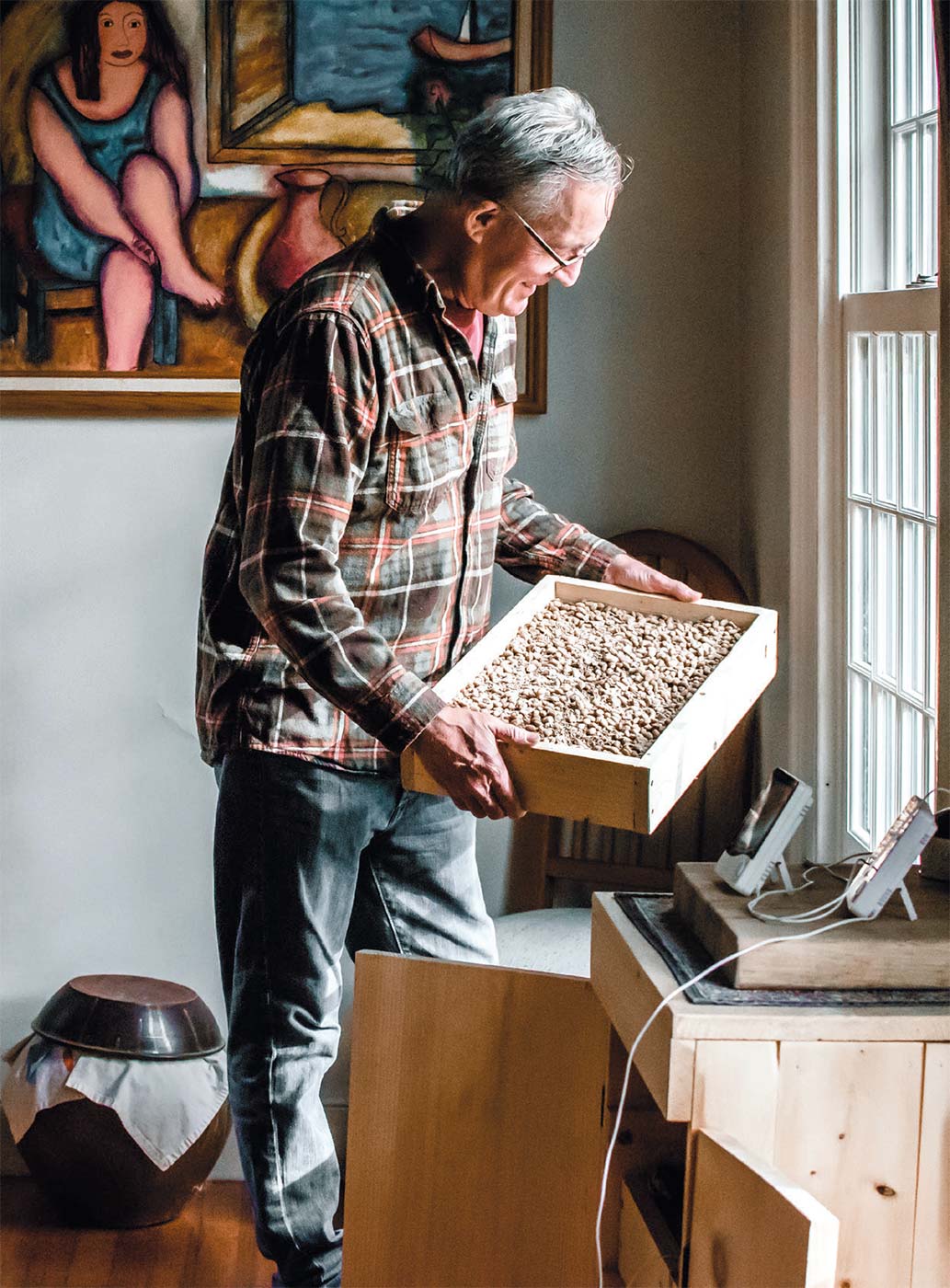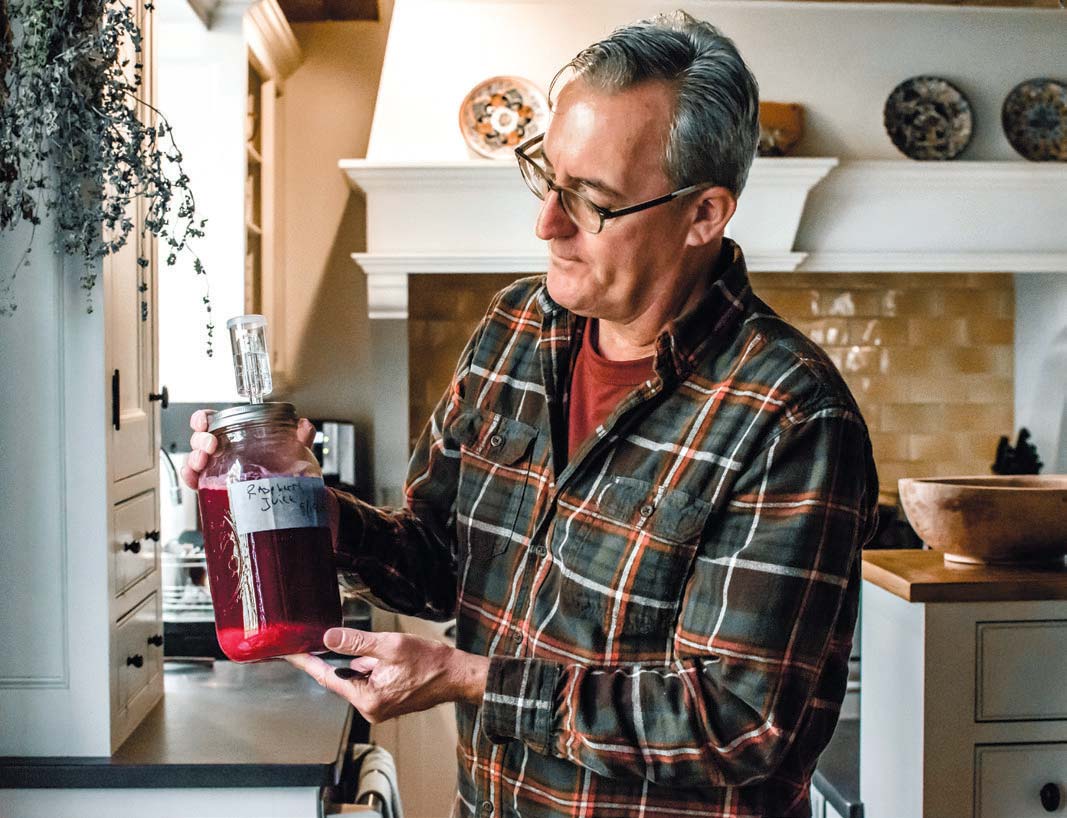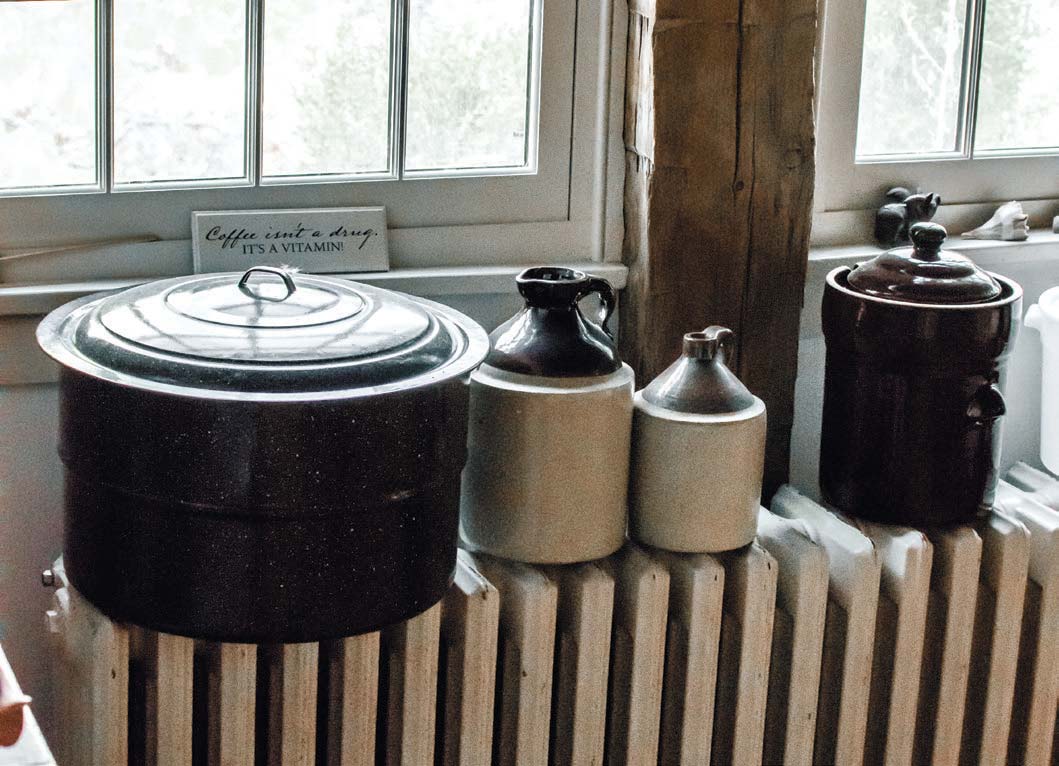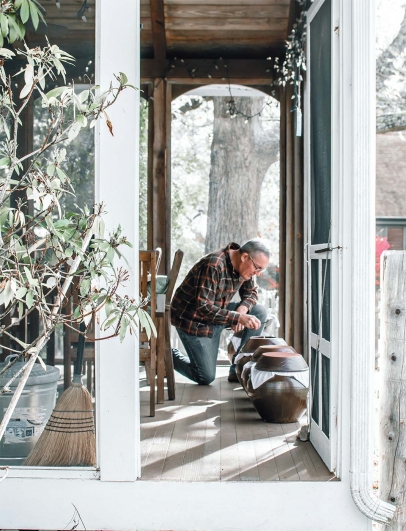In Mystic, Bob Florence is Mastering the Art of Fermentation
If you’re familiar with wine tasting or craft beer flights, the concept of shoyu (Japanese style soy sauce) tasting will make sense to you. But what won’t likely make sense to you is the tremendous range and depth of flavors you’ll experience through the tasting.
We recently had this experience in the home of Bob Florence, chief maker of some of the most amazing shoyu we’ve ever tasted, as well as the owner of Haley Brook Foods in Mystic. Bob’s 200-yearold farmhouse is the perfect laboratory with buckets and bottles and beakers, oh my, in every corner, nook, across the basement, and throughout an upstairs bedroom. The presence of slowly fermenting soybeans and rice is oddly calming and even the sometimes strong smells are warming.
Bob’s path to this farmhouse laboratory was circuitous but seems divine in retrospect. Growing up working on his grandfather’s small farm and farm stand, and even putting himself through school at SUNY College of Environmental Science and Forestry in Syracuse while working as a produce manager at IGA, Bob has always had an interest in farmers and growing food. However, when he became a chemist he traced a commercial path in plastics (back when they were advanced technology) with companies like GE and Apple. This led to many years working and living across Asia in China, Japan, India, and Korea where he was happily exposed to the foods that would change his life.
After a thorough education in the industrial side of the world, Bob turned to renewables, working at Solazyme essentially fermenting algae which of course led to more exploration. “Chemists like to mix stuff together. Most chemists like to cook and experiment”, says Bob. “I started out just to make soy sauce and that was then my whole goal in life.”
“I had already been making soy sauce based on various formulas and I made some pretty reasonable soy sauce. But as I got into it, I realized it's really interesting. It's quite a complicated process, but it's also a really natural process.”
Some 3000 years ago humans came across soybeans in storage and found mold on them. “They're thinking, well, what are we going to do with that stuff? They ended up eating it and obviously figured out it was tasty!”
“Every culture has fermented foods. As humans evolved, we naturally collected food, stored food, and of course, food naturally started fermenting. Then as we continued to evolve, we actually began to direct that fermentation and started controlling it. So rather than having fermentation that was just out of control, where we didn't know what was going on, we actually down-selected specific molds. Then we tried to figure out temperature, humidity, and the culture of the type of mold that we're doing.”
Bob continues, “It's amazing. We've actually down selected molds like we did for wheat, for corn, we down selected things for what we liked. Basically, when you're using molds to do fermentation, your molds are growing on a substrate and they're injecting enzymes into the substrates to break down sugars, proteins and lipids and fats.
Those enzymes actually make the substrate easier to digest. So rather than digesting a whole big protein molecule, we're now basically consuming amino acids or rather than digesting really complicated starches, we're now digesting simple sugars. And the same with lipids, breaking those down into really friendly molecules.”
“We started out fermenting soybeans and those were the original basis for soy sauce. But of course, people figured out that by adding wheat they could change not only the flavor profile but could also direct the fermentation more favorably because the wheat helps balance the water content. The molds don't like to be really wet but they don't like to be too dry either. It’s a way of kind of mitigating over humidified atmospheres or too much moisture on beans.”
Realizing he still had much to learn, Bob contacted some 15 Japanese shoyu companies, telling them what he was doing, asking to meet with them. Three of the companies replied positively so Bob went to Japan to visit them. He focused on a company called Chiba Shoyu based in the Chiba prefecture, one of the largest soy manufacturing regions in Japan. Part of what attracted Bob is that the company still produces fabulous shoyu based on the old traditions.
Using koji spores, the actual mold, accelerates the age-old process. “We inoculate the base, rice, steamed soybeans, and/or roasted wheat, and then the koji mold grows on that substrate and it'll grow into basically a big matted mess. It’s not like you get a layer of mold on the top and you pull that mold off. The mold actually grows up through the rice substrates. It actually sends mycelium into the substrate.
It’s digesting the rice and pulls out a lot of carbohydrates, so it's a lot sweeter. You have a lot of sugars in rice whereas the soybeans are a lot of protein, so you're getting more amino acids. This is actually the precursor to soy sauce, miso, tamari, sake, and vinegars.”
The liquid that pools on top of miso is tamari which of course can be harvested. We originally fermented miso to collect tamari with miso as a byproduct. But again, historically, we humans said, “Hey, we really liked that. How can we make more of that?” So now the miso and tamari can be blended to create a sort of creamy miso. Bob however, prefers more of a farmhouse style miso, chunkier. “I like the chunkiness and it's like, well downstream, if somebody wants creamy they can cream it!”
We started our tasting with the Shiro Miso. This is a sweet white miso, originating in Kyoto in Western Japan. And then a white miso was which sweeter, but we swear there was an interesting tang to it. The adzuki bean miso was also delicious with a somewhat darker, more roasted flavor.
“As humans evolved, we naturally collected food, stored food, and of course, food naturally started fermenting. Then, we realized, wow! This is tasty.”





After starting with a wonderful tasting of miso and shoyu, Bob shares just a few of the processes and experiments happening around the house.
There are innumerous ways to enjoy miso. Bob likes to put it on salmon and let it marinate. When you throw it on the grill, the sugars in the miso carmelize and actually stick to the fish. Bob elaborates, “Yeah, I like it with shrimp, scallops, salmon, you know, anything that has a little mellower flavor is really enhanced by the miso tang. I've had some chefs who put it in caramel sauce. It's really good!”
We begin to dip our fingers into the shoyu tasting bowls. “This is called koikuchi. And koikuchi style is roughly 90% of the soy sauce in the world. It's 50% wheat, 50% soybeans. And this one is saishikomi style, it's twice brewed. For saishikomi, they actually use soy sauce to make soy sauce. They don't use salt and it's brewed for like two years.” The saishikomi produced an interesting, complex flavor to us.
Next, we then tried a mellow sauce of unpasteurized whole soybean and wheat, then Bob recommends trying the koikuchi sauces together. Both are delicious but difficult for an amateur to distinguish between the Yamaki and the Chiba. They're very similar styles.
Next, “Ogura shoyu is actually one of my favorites, I think you’ll like that,” notes Bob. And it was amazing. We noted something like a seafood taste that Bob appreciated but politely didn’t really agree with! He does find the Ogura story interesting in that their factory is very much a mom and pop operation. “It's a husband and wife and his father and it goes back four or five generations of brewers. The family does it all. That's all they want. I love their factory because it was put together over a hundred years ago. You can tell how it sort of grew organically. Definitely not like a highly industrialized type of operation, but likely the closest to an artisanal type of product that you can get.”
Bob’s shoyu, his Haley Brook brand, was honestly our favorite. Rich and complex yet smooth and not overly salty. Last was the Kikkoman, which actually wasn’t bad. It simply lacked the depth of flavors of all the others. Yet, it’s still the best-selling soy sauce in the world.
Bob continues, “To use a music analogy, I tend to think of it more like a single note versus a chorus or chord. The others do so much more in your mouth.”
“I brought my soy sauce to Ogura, to Yamaki, and to Chiba when I first went over to Japan and started talking to them. And I met with Mame Yamaki, who is like a fifth-generation owner. And she tasted my shoyu and she says, ‘This is beautiful’, which I took as a pretty big compliment, a great compliment! Then she said, ‘But we couldn't make it here.’ It's not because they don't have the technology or even the desire, it's that the pure cultural expectations and taste expectations are different there. They have an industry body that regulates the manufacture of shoyu so there's some guardrails on the whole thing.”
The measurement points are pH levels, alcohol content, protein content, color, and turbidity which all have to work in balance. Bob actually had his shoyu analyzed by Chiba. He says, “They've taken full lab readouts of it and it's actually really close to their specifications with the exception of color and turbidity. I make my shoyu out of whole soybeans while most of the soy sauce industry is based on defatted soybeans. Those are soybeans that have been pressed to extract the oils and sold as soybean oil. And then the grits that are left over are used for the majority of soy sauces.”
"I've asked all these guys about, you know, the merits of whole soybean versus defatted soybean. People argue that both styles have merit and some argue that defatted soy beans have more flavors than whole soybeans while others say not true. So, I think, like wine, you could debate whether Cabernet is better than Merlot. I choose to go with whole bean soy because I think it gives a rounder taste, a deeper flavor profile than other styles."
While Bob focuses on shoyu as his first commercial product, he’s also experimenting varying combinations of soybeans, rice, wheat, adzuki beans, potatoes, shitake mushrooms (from his friend Chris Pacheco at Seacoast Mushrooms), peppers, and more. It seems that it’s all connected and and Bob is anxious to try it all!
Bob’s passions and his career have taken him from farming to chemistry to industry to fermentation. It was very organic, but when you look back now there's a definitive sort of thread that goes through his path. Even though it seems wildly diverse, in retrospect, it looks all brilliantly coordinated.
“No not all all. I’m just an old chemist who likes to play with things and see what happens!” Luckily for us the things Bob plays with are delightfully tasty and hopefully we’ll be able to taste them more frequently once he gets the new Haley Brook manufacturing facility up and running!
- Follow Bob Florence on Instagram @bob.florence

Bob also grows his own chiles and is working on a number of hot sauces.





